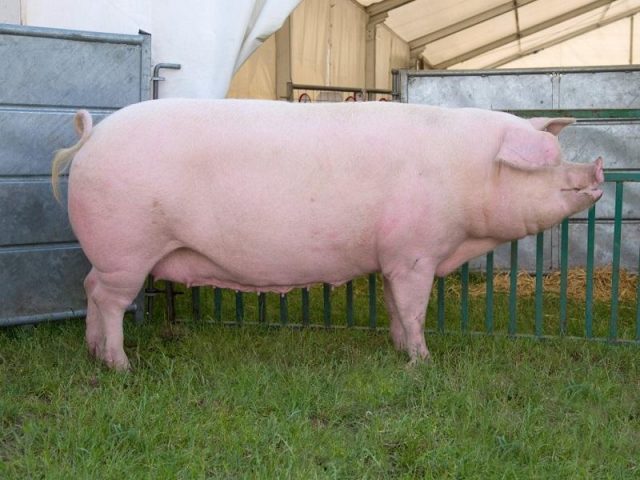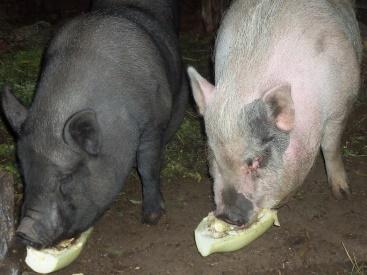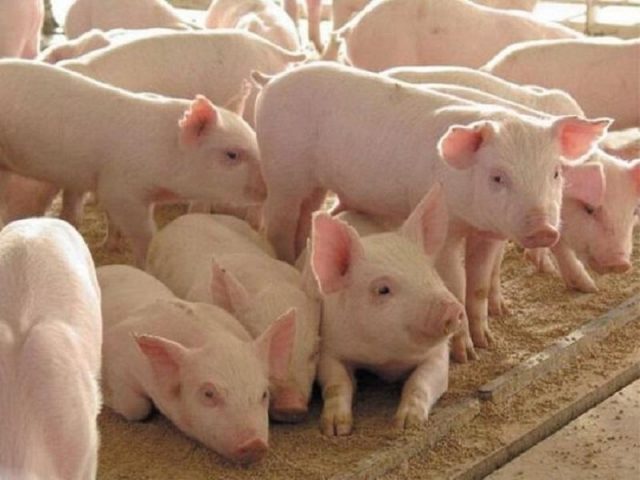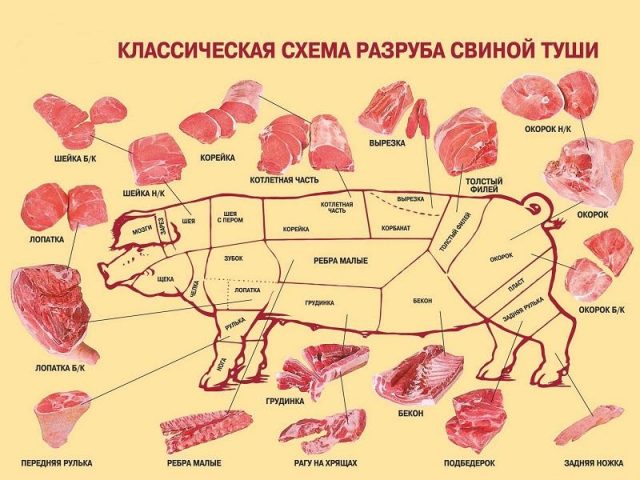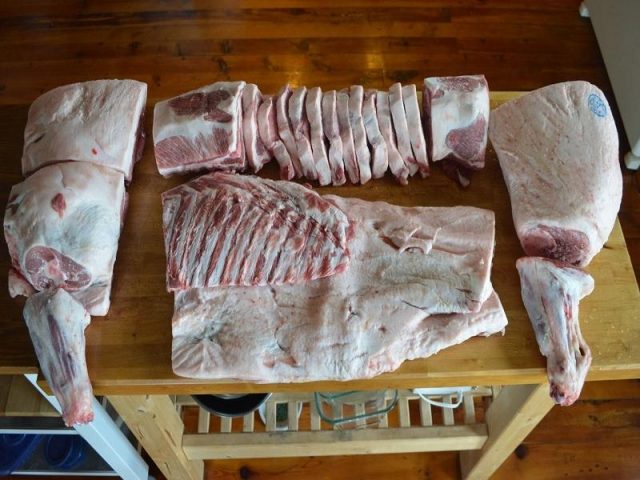Content
The livestock farmer needs to be able to determine the pork yield from live weight in different ways. Its percentage depends on breed, age, feeding. The slaughter weight of the pig helps to pre-calculate the profit of the farm, determine the profitability of production, and adjust the feeding rates.
Average pig weight at slaughter
Age, breed, diet of an animal directly affect weight. To determine the time of slaughter, the estimated slaughter weight of the pig, the state of health of the animal and the preparation of the feeding ration, it is necessary to be able to correctly determine the weight of the animal.
Representatives of the Great White breed in adulthood reach impressive sizes: a wild boar - 350 kg, a pig - 250 kg. The Mirgorod breed is smaller, individuals rarely reach 250 kg.
A Vietnamese wild boar weighs 150 kg, a pig 110 kg.
The increase in piglet weight gain depends on the correct formulation of the diet, the quality of the feed, and the season. The mass of the animal increases in the spring, when healthy greens are added to high-calorie feed. The indicator is influenced by the fatness of the pig, which is represented by five categories:
- the first - young growth of bacon type, up to 8 months, weighing 100 kg;
- second - young meat, up to 150 kg, pigs - 60 kg;
- third - fat individuals with no age limit with a fat thickness of 4.5 cm;
- fourth - sows and hogs and heavier than 150 kg, whose fat thickness is 1.5 - 4 cm;
- fifth - dairy pigs (4 - 8 kg).
Weight gain largely depends on the diet, the addition of vitamins to the pig's feed, and the conditions of detention. With a balanced and caloric diet, the animal can gain 120 kg by six months. This weight gives a high slaughter yield in pigs.
How much does a boar weigh
Adult boars weigh more than pigs. The difference is 100 kg. Average values of different breeds of adult boars (in kg):
- Mirgorodskaya - 250, at breeding enterprises - 330;
- Lithuanian white - 300;
- Livenskaya - 300;
- Latvian white - 312;
- Kemerovo - 350;
- Kalikinskaya - 280;
- Landrace - 310;
- Large black - 300 - 350;
- Large white - 280 - 370;
- Duroc - 330 - 370;
- Chervonopolisnaya - 300 - 340;
- Estonian bacon - 320 - 330;
- Welsh - 290 - 320;
- Siberian North - 315 - 360;
- Ukrainian steppe white - 300 - 350;
- North Caucasian - 300 - 350.
Piglet weight before slaughter
The specific weight of the pig at different ages allows you to adjust the quality and quantity of feedings. For all breeds, there are average indicators of the mass of the animal. So, the Large White piglet is much heavier than the Asian herbivore. Piglet weight, depending on age, is approximate.
The indicator is influenced by the size of the sow's farrowing. The more numerous it is, the easier the pigs are. The first month, the gain depends on the milk yield of the pig. From the second month, the quality of nutrition affects the growth of piglets.
Concentrated feed promotes rapid weight gain. A diet based on herbs, vegetables and fruits slows down the rate of gain in pigs. When comparing piglet weights with guideline values, feed information should be considered. Increase in piglet weight gain by month (on average, in kg):
- 1st - 11.6;
- 2nd - 24.9;
- 3rd - 43.4;
- 4th - 76.9;
- 5th - 95.4;
- 6th - 113.7.
The error in the mass of Landrace, Large White and other breeds not fattened before slaughter for more than six months is 10%.
What determines the lethal output
After the slaughter of the animal, part of the weight is lost due to evisceration of the carcass, release of blood, separation of the legs, skin, head. The percentage of pork meat yield from live weight is called slaughter yield. The indicator is influenced by the type of animal, breed characteristics, age, fatness, gender. It is widely used to assess the quality of livestock. The yield of pork from a carcass depends critically on the accuracy of measuring live weight. If it is incorrectly determined, the error reaches large values.
So, the weight of a pig carcass fluctuates, depending on the weighing time. When paired, it is 2 - 3% heavier than chilled. The body tissues of a young animal contain more moisture than an adult, therefore, the loss of kilograms after slaughter in the first case is more significant.
The change in mass is higher for oily carcasses than for lean carcasses.
The product yield is influenced by:
- diet - weight gain from fiber is less than from dense food;
- transportation - during the delivery time to the slaughterhouse, the animals become lighter by 2% due to stress;
- lack of feeding - before slaughter, 3% of the mass is lost in 24 hours without food, since the body spends energy on mobilizing vital functions.
Slaughter output of pig meat
Slaughter yield in pigs is 70 - 80%. It is equal to the ratio of the mass of the carcass to live, expressed as a percentage. Slaughter weight of pigs includes carcass with head, skin, fat, legs, bristles and internal organs, excluding kidneys and kidney fat.
Calculation example:
- With a live weight of a pig of 80 kg, carcasses without legs and offal (excluding kidneys) - 56 kg, the slaughter yield is: 56/80 = 0.7, which is equal to 70% in percentage;
- With live weight - 100 kg, slaughter - 75 kg, the yield is: 75/100 = 0.75 = 75%;
- With a live weight of 120 kg and a carcass of 96 kg, the yield is: 96/120 = 0.8 = 80%.
Judging by the indicator, raising pigs is more profitable than cattle and sheep. The yield of products, in comparison with other animals, is 25% higher. This is possible due to the low bone content. In cattle, there are 2.5 times more of them than in pigs.
Slaughter yield in farmed animals is:
- cattle - 50 - 65%;
- sheep - 45 - 55%;
- rabbits - 60 - 62%;
- bird - 75 - 85%.
How much does a pork carcass weigh?
In a pig, the yield of meat, lard, by-products depends on the breed, age, weight of the animal itself.
All bred breeds are divided into three groups:
- Bacon: Pietrain, Duroc, quickly gaining kilograms with a slow build-up of fat and fast - muscle; have a long body, massive hams;
- Greasy: Hungarian, Mangalitsa, have a wide body, heavy front, meat - 53%, fat - 40%;
- Meat: Livenskaya, Large White - versatile breeds.
When the live weight of a pig reaches one hundred or more kilograms, the slaughter yield is 70 - 80%. The composition, in addition to meat, includes about 10 kg of bones, 3 kg of waste, 25 kg of fat.
Visceral weight
The mass of liverworm products depends on the age of the pig, its breed, size. For a carcass of 100 kg, it is (in kg):
- heart - 0.32;
- lungs - 0.8;
- kidneys - 0.26;
- liver - 1.6.
The percentage of viscera in relation to the total slaughter yield is:
- heart - 0.3%;
- lungs - 0.8%;
- kidneys - 0.26%;
- liver - 1.6%.
What is the percentage of meat in a pig
After slaughter, the pigs are divided into half carcasses or quarters. Further, they are divided into cuts, boning, trimming, stripping.
Deboning is the processing of carcasses and quarters, in which muscle, adipose, and connective tissues are separated from the bones. After it, there is practically no meat on the bones.
Vein - separation of tendons, films, cartilage, remaining bones.
On different parts of the half carcasses, the output of pork meat after deboning is of different quality. This is the peculiarity of the procedure. So, when deboning the brisket, back, shoulder blades, meat of lower grades is cut off than from other parts. This is due to the large number of veins and cartilage. The zhilovka provides, in addition to further cleaning, the final sorting of pork. It is divided into muscle groups, cut longitudinally into kilogram pieces, and the connective tissue is separated from them.
When the carcass after slaughter is taken as one hundred percent, the yield rates for deboning pork are:
- meat - 71.1 - 62.8%;
- lard - 13.5 - 24.4%;
- bones - 13.9 - 11.6%;
- tendons and cartilage - 0.6 - 0.3%;
- losses - 0.9%.
How much pure meat is in a pig
Pork has been divided into five categories:
- the first is bacon, animals are specially fed, there are layers of fatty and highly developed muscle tissue;
- the second is meat, it includes carcasses of young animals (40 - 85 kg), the thickness of bacon is 4 cm;
- the third is fatty pork, fat more than 4 cm;
- the fourth - raw materials for industrial processing, carcasses heavier than 90 kg;
- the fifth is piglets.
Fourth, fifth categories: pork, frozen several times, products obtained from boars are not allowed for sale. The output of pork cuts to carcass weight is 96%.
The output from a pig of meat, lard and other components with a live weight of 100 kg is (in kg):
- internal fat - 4.7;
- head - 3.6;
- legs - 1.1;
- meat - 60;
- ears - 0.35;
- trachea - 0.3;
- stomach - 0.4;
- liver - 1.2;
- language - 0.17;
- brains - 0.05;
- heart - 0.24;
- kidneys - 0.2;
- lung - 0.27;
- trim - 1.4.
How much meat is in a pig weighing 100 kg
When pigs that have gained 100 kg are slaughtered, the yield is 75%. Carcasses with a high percentage of bacon are obtained from fattening hybrids of three breeds: Landrace, Duroc, Large White. Bacon meat is rich in muscle tissue, thin lard. It ripens on the 5-7th day after slaughter, when its nutritional value becomes maximum, and its properties are optimal for further processing. After 10 - 14 days it is the most tender and juicy. The average weight of half carcasses is 39 kg, fat has a thickness of 1.5 - 3 cm. Percentage of pure meat yield from a pig carcass:
- carbonate - 6.9%;
- shoulder blade - 5.7%;
- brisket - 12.4%;
- hip part - 19.4%;
- cervical part - 5.3%.
Conclusion
The yield of pork meat from live weight is quite high - 70 - 80%. There is little waste after cutting, so the pig is beneficial for obtaining meat. Thanks to the multitude of bred breeds, it is possible to select individuals for breeding, unique in their properties, meeting the market requirements and customer requests. When raising pigs, it is worth constantly monitoring the weight gain and, if necessary, adjusting this with feed.
